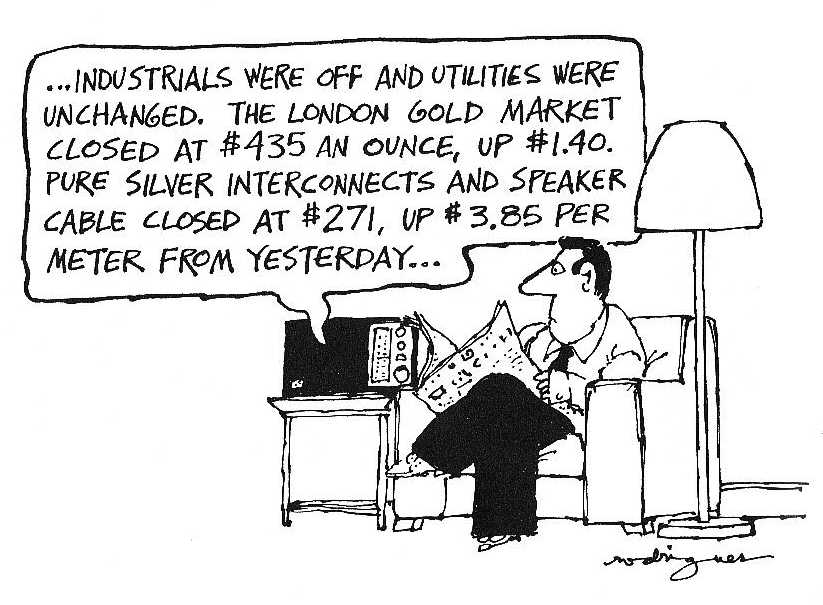Yes you can! Let's say 12 ga for one leg and 16 ga for the other. I can't think of a reason why this configuration should sound worse than symmetrical. Nor can I see any benefit. Go ahead, build it and try it out! At least its not a wacky idea like wire directionality!
Can one use assymetric wire gauge for speaker cable construction?
Hello,
I am trying to build a DIY speaker cable, but while doing so I have one question that needs to be answered. I am using a cable which is essentialy made up of multuple individually insulated cables of smaller gauge.
So can I use more strands for the positive wire & lesser strands for negative wire, essentially an asymmetric gauge design. But length of both positive & negative wires will be same (and between left & right channel).
Can someone please help me answer this question?
Regards,
Saurabh
The for using assymetric gauge came from the idea that can I use power cables as speaker cables. Ignoring the fact that these are heavier and inflexible compared to speaker wires, shielding on these is much better than ordinary wires & gauge is also pretty thick. So if one can use asymmetic gauge then power cables can be very interesting choice for speaker cables.
Saurabh |
Yes... but why?
You can bundle together into a single conductor multiple differeng gauges into a single larger effective gauge. You can also use 2 different effective gauges for + and - to some degree.
You must ensure each conductor has a safe minimum gauge for the current carrying, and this depends on the length as well as the power and speaker impedance. You could often use 16 gauge for small HT type speakers, but I'd recommend 14 as a minimum. So long as your two conductors are at least 14 gauge you should be OK. |
@audio_phool - The speaker cables I and many others have built use 2 x 16 gauge solid UP-OCC copper wire (or 2 x 14 gauge) for the signal and 1 x 10 gauge Silver plated stranded Mil-Spec wire for the Neutral wire and they sound excellent Here’s a link for DIYer’s on how to make them And here’s what other Audiogon members think of them https://forum.audiogon.com/discussions/duelund-conversion-to-diy-helix-geometry-cabling If you have and questions just post them on the thread above Regards - Steve |
I think this will be helpful regarding bi-wiring, the reason for different guages
I chose to believe in small diameter individual strands, so I make my own speaker wires using cat 8: 8 22awg = 13 awg, each strand insulated; each pair foil wrapped, those 4 pairs insulated, ofc copper. two different colored legs, thus red = 8 positive, black = 8 negative = 13 awg. double your length of each color for a pair, add some slack, cut in half, cut the factory ends off, pure copper spades ... |
Shielding can sure kill the sound of a speaker IC. I'm prone to mini solid core individually insulated with teflon and then a weave 8-24 strands, I like ribbons too. Actually one of my favorites is the combination of the two, The weave is OCC with Teflon and the ribbon is OCC/silver clad with teflon.. I also add a stinger of 99.99% tungsten in an air tube of silicone on the + side only.. Who cares I'll try almost anything... :-) |
@audio_phool - About 15 years ago, or so, there was an article in The Absolute Sound, where the reviewer made a pair of speaker cables using a 3 wire, 14-gauge outdoor extension cord from The Home Depot. He used 2 of the 3 wires for the + side and the remaining 1 of the 3 wires for the - side. It caused quite a stir back in the day. I built a pair and used them regularly for temporary use in my system. I never terminated them, just used the bare copper ends, so they were not as convenient as my purpose built speaker cables with BFA style low-mass banana plugs. Yes, you can build an asymmetric cable and it will sound fine. Of course, you could use the same type of extension cord and just use 2 of the 3 conductors and have a symmetric cable. |
Jmho, a power cord, cable, would be a bad choice. Especially if the power cord is UL Listed. If UL Listed as a rule the insulation, dielectric, covering the conductors is rubber or PVC... Not good for carrying audio signals. Also as @oldhvymec pointed out shielding is not a good idea. It can suck the air from the music. . |
There is one caveat pertaining to asymmetric cables and that is they DO NOT work well with amplifiers that adopt a balanced symmetrical differential design. i.e. - where both speaker output terminals carry the same signal, but 180 degrees out of phase This style of amplifier REQIES prefect symmetry between both +ve and -ve conductors - i.e. wire type, gauge, insulation type and cable geometry There are several amps that use this approach and the list appears to be growing quite fast - but at this point in time they tend to be higher end products. Here are a few
Regards - Steve |


